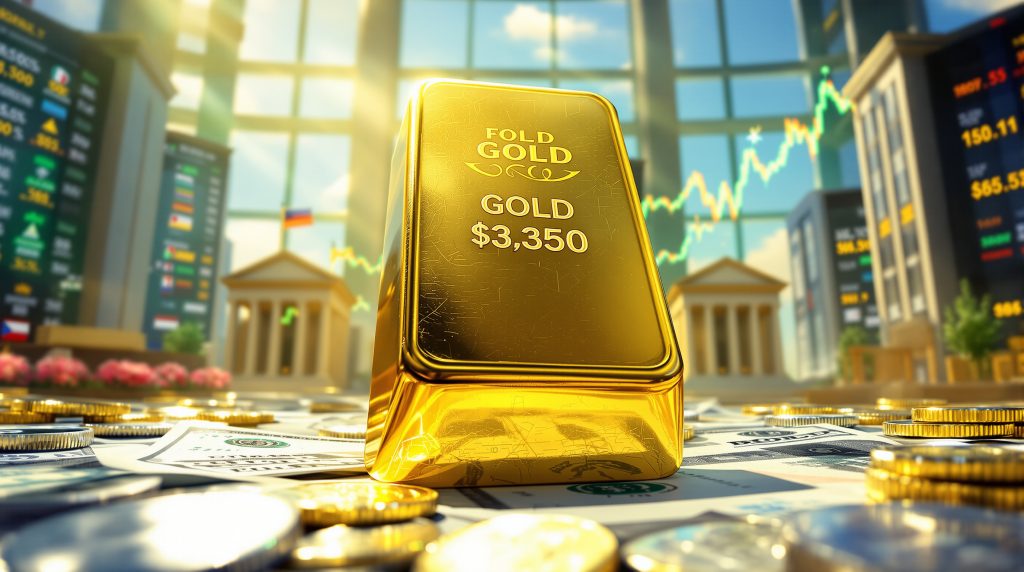The Evolution of Gold's Status in Global Finance
Gold has solidified its position as the primary alternative to the US dollar in global finance, surpassing other contenders like the euro or Chinese yuan. Throughout history, gold has maintained a unique appeal that transcends borders, cultures, and economic systems. Unlike fiat currencies, gold's value isn't dependent on any government's promise, making it a truly universal store of value during uncertain times.
The metal's transition from a historical currency backing to a modern financial safe haven has accelerated in recent decades. This transformation became particularly evident during the 2008 financial crisis and subsequent monetary expansion, when gold demonstrated remarkable resilience compared to traditional paper assets.
What makes gold particularly effective as a gold as a dollar alternative is its limited supply. While central banks can create unlimited amounts of currency, the world's gold supply increases by only about 1.5-2% annually through mining operations. This natural constraint provides a powerful inflation hedge role against currency devaluation.
Central Banks' Strategic Gold Accumulation
Central banks worldwide have dramatically increased their gold reserves in recent years, with global official gold holdings now exceeding 35,000 metric tons. This buying continues regardless of price fluctuations, indicating a fundamental shift in how monetary authorities view gold within their reserve diversification strategies.
China has been at the forefront of this trend, adding gold to its reserves for 17 consecutive months as of early 2024. Russia, Turkey, and India have similarly expanded their gold holdings, often reducing their dollar reserves simultaneously. These strategic decisions reflect growing concerns about dollar dependence and the search for monetary sovereignty.
Even Western central banks, which had been net sellers of gold for decades, have reversed course. The European Central Bank and many of its member nations have halted gold sales and in some cases become buyers again. This worldwide accumulation demonstrates gold's evolving role from a legacy asset to an active strategic holding in the modern financial system.
What Drives Gold's Strength in Today's Economy?
Government Debt Concerns and Monetary Policy
The unprecedented expansion of government debt globally has become a primary catalyst for gold's appeal. The United States alone has seen its national debt surpass $34 trillion in 2024, with annual deficits consistently exceeding $1 trillion. This mounting debt burden creates fundamental questions about the long-term stability of fiat currencies.
What makes the current debt situation particularly supportive for gold as a dollar alternative is the apparent lack of political will to address these imbalances. With limited credible attempts to reduce debt burdens, investors increasingly question whether governments will resort to currency devaluation as a partial solution. In this environment, gold's lack of credit or counterparty risk becomes especially attractive.
The response to recent economic crises has typically involved massive expansions in central bank balance sheets. The Federal Reserve's assets grew from under $1 trillion before 2008 to over $8 trillion today, creating monetary conditions that historically benefit precious metals. This relationship between monetary expansion and gold appreciation forms a cornerstone of gold's investment case.
Interest Rate Trajectories and Gold Performance
The conventional wisdom that gold suffers in high interest rate environments has been challenged by market realities. While gold does not pay interest or dividends, its performance correlates more strongly with the direction of interest rates rather than absolute levels.
Recent market behavior has demonstrated that gold can perform well even before actual rate cuts materialize, as investors position themselves ahead of anticipated policy shifts. The market's forward-looking nature means gold often begins rising when the market perceives that interest rates have peaked, not when they actually begin falling.
Historical analysis shows that during the 1970s, gold appreciated dramatically despite rising interest rates, as inflation outpaced nominal yields, resulting in negative real rates. Today's environment shares some characteristics with that period, with inflation remaining stubbornly above the Federal Reserve's 2% target despite higher nominal rates.
"What matters for gold isn't the absolute level of interest rates, but whether those rates are sufficient to compensate for inflation and currency risk. When they aren't, gold shines." – Financial analyst quoted in Bloomberg
How Does Gold Compare to Other Safe Haven Assets?
Gold vs. Traditional Currency Alternatives
Despite numerous attempts to establish other currencies as dollar alternatives, gold has maintained its position as the preeminent safe haven. The euro, initially positioned as a potential challenger to dollar dominance, has faced structural challenges within the eurozone that limit its appeal as a reserve asset. Similarly, the Chinese yuan, despite China's economic size, remains constrained by capital controls and convertibility limitations.
Bitcoin and other cryptocurrencies have emerged as potential digital alternatives, but their extreme volatility and relatively short history make them speculative rather than proven safe havens. Gold's 5,000-year track record of preserving purchasing power provides a level of confidence that newer alternatives simply cannot match.
The Japanese yen, once considered a reliable safe haven currency, has lost much of this status due to Japan's massive government debt and ongoing monetary stimulus. This shift has further consolidated gold's position as the preferred non-dollar store of value for global investors seeking stability.
Physical Properties vs. Financial Instruments
Gold's physical properties give it fundamental advantages over purely financial instruments. Its scarcity is guaranteed by physics and geology—only about 200,000 tons have ever been mined throughout human history. Unlike financial assets that can be created or destroyed, gold atoms remain permanently in existence.
These intrinsic qualities become particularly valuable during periods of financial stress or geopolitical uncertainty. During the 2020 COVID-19 market turbulence, many paper gold substitutes briefly traded at significant discounts to physical gold, highlighting the premium markets place on actual physical ownership during crises.
The metal's durability means gold mined thousands of years ago remains in circulation today. This permanence contrasts sharply with the historical pattern of fiat currencies, which have typically lost value or disappeared entirely over sufficient time periods. As one gold analyst noted, "The dollar has lost over 98% of its purchasing power since the Federal Reserve was established in 1913, while an ounce of gold buys approximately the same amount of goods as it did a century ago."
What Are the Current Market Dynamics for Gold?
Record Price Movements and Market Sentiment
Gold has experienced remarkable price appreciation, reaching unprecedented levels around $3,350 per ounce in 2024. This represents more than a 70% increase from its 2022 lows. Despite these significant gains, market sentiment analysis suggests continued upward potential for the all-time high analysis.
A notable characteristic of the current gold bull market has been its pattern of consolidation followed by new highs. After reaching each new price milestone, gold typically trades sideways for several weeks before continuing its upward trajectory. This stair-step pattern indicates healthy market absorption of higher prices rather than speculative excess.
Interestingly, gold's rise has occurred despite relatively modest participation from Western retail investors. ETF holdings remain below their 2020 peaks, suggesting potential for additional buying pressure if mainstream investment sentiment shifts more decisively toward precious metals. This untapped demand represents a potential catalyst for future price appreciation.
Volatility Factors in the Gold Market
Several factors contribute to gold's market volatility, creating both risks and opportunities for investors. Geopolitical tensions in the Middle East, the Russia-Ukraine conflict, and ongoing trade disputes between major economies have all influenced gold prices in recent years.
Policy uncertainties also impact gold markets. Recent discussions about potential tariffs on imported gold bars created short-term market disruptions, highlighting how regulatory decisions can affect precious metals prices. These policy-driven volatility events often create buying opportunities for long-term investors focused on gold's fundamental value proposition.
Gold's volatility is also influenced by positioning in the futures markets. Commercial hedgers, speculators, and large institutional traders create complex market dynamics that can temporarily move prices away from fundamentals. Understanding these technical factors helps investors distinguish between short-term noise and the longer-term uptrend in the gold market surge.
How Are Investment Vehicles Changing Gold Accessibility?
The ETF Revolution in Precious Metals
Exchange-traded funds have revolutionized how investors access gold and other precious metals. Before the introduction of gold ETFs in the early 2000s, investors seeking gold exposure faced significant hurdles related to storage, insurance, and authenticity verification. Physical gold ETFs solve these logistical challenges while maintaining the benefits of gold ownership.
The world's largest gold ETF, SPDR Gold Shares (GLD), now holds over 30 million ounces of physical gold in secure vaults. This innovation has dramatically broadened gold's investor base, bringing in participants who previously might not have considered gold as an investment option. Institutional investors particularly appreciate the liquidity and ease of implementation that ETFs provide.
Beyond simple gold tracking products, the ETF landscape now includes specialized vehicles focused on undervalued mining stocks, junior explorers, royalty firms, and various combinations of precious metals. This ecosystem allows investors to customize their exposure based on their risk tolerance and market outlook.
Impact on Traditional Gold Investments
The rise of gold ETFs has created both challenges and opportunities for traditional gold investments. Physical bullion dealers have adapted by emphasizing the benefits of direct ownership and developing online platforms that make purchasing and storing physical gold more convenient.
Gold mining companies have experienced a complex relationship with ETFs. While physical gold ETFs have diverted some capital that might otherwise have flowed to mining equities, specialized mining ETFs have channeled investments into selected operations. Mining firms with strong production growth, low costs, and disciplined capital allocation have attracted premium valuations.
The relationship between physical gold and mining stocks has evolved as the sector matures. Historically, mining equities provided leverage to gold prices but suffered from poor corporate governance and value destruction through ill-advised acquisitions. Today's leading gold producers have embraced shareholder-friendly policies including meaningful dividends and share repurchases, creating new investment cases beyond simple gold price exposure.
How Does Silver Fit into the Precious Metals Landscape?
Silver's Dual Nature as Industrial and Precious Metal
Silver occupies a unique position as both an industrial metal and a precious metal with monetary history. Approximately 50% of silver demand comes from industrial applications including electronics, solar panels, and medical devices. This industrial component creates different price dynamics compared to gold.
Silver's industrial applications continue to expand, particularly in green technologies. Each solar panel contains approximately 20 grams of silver, while electric vehicles use nearly twice as much silver as conventional cars. These growing use cases provide fundamental support for silver demand beyond its monetary aspects.
Despite these industrial characteristics, silver maintains its precious metal status. When gold prices rise substantially, silver typically follows and often outperforms on a percentage basis. This relationship reflects silver's historical monetary role and its perception as "poor man's gold" during periods of financial uncertainty.
The Gold-Silver Ratio and Investment Implications
The relationship between gold and silver prices, expressed as the gold-silver ratio, provides important insights for investors. This ratio shows how many ounces of silver are needed to purchase one ounce of gold. Historically, this ratio has averaged between 40:1 and 60:1, though it has experienced significant fluctuations.
In early 2020, the ratio reached an extreme of 125:1 as pandemic concerns initially hit silver harder than gold due to industrial demand fears. Since then, the ratio has moderated but remains elevated by historical standards at approximately 88:1 in mid-2024. This suggests potential for silver outperformance if the precious metals bull market continues.
Silver's greater volatility creates both opportunities and risks. While gold might rise 20% in a bull market phase, silver often gains 30-40% during the same period. However, this pattern works in reverse during corrections. Investors often use silver's responsiveness to develop trading strategies around the gold-silver ratio, buying silver when the ratio is historically high and shifting to gold when it narrows.
What Economic Factors Are Supporting Gold Prices?
Inflation Trends and Monetary Policy Expectations
While headline inflation has moderated from recent peaks exceeding 9%, core inflation remains stubbornly above central bank targets in many economies. In the United States, core CPI continues to run above 3%, significantly higher than the Federal Reserve's 2% target despite aggressive interest rate hikes.
This persistent inflationary environment, combined with expectations for interest rate cuts, creates particularly favorable conditions for gold as a dollar alternative. Markets currently anticipate that central banks, particularly the Federal Reserve, will begin easing monetary policy in late 2024. This anticipated pivot toward looser monetary conditions typically benefits non-yielding assets like gold, as reflected in current gold price forecast models.
The composition of inflation has shifted from goods to services, making it potentially more resistant to monetary tightening. Housing costs, healthcare, and education continue to experience price increases well above the headline inflation rate. This "sticky" inflation suggests that real interest rates (nominal rates minus inflation) may remain negative even after accounting for current Fed policy.
Consumer Confidence and Economic Uncertainty
Declining consumer confidence provides additional support for gold prices. Despite headline economic growth, surveys show persistent concerns about financial security and economic prospects. The University of Michigan Consumer Sentiment Index remains below pre-pandemic levels, reflecting ongoing economic anxiety.
This uncertainty manifests in consumer behavior, with households maintaining elevated savings rates compared to pre-pandemic norms. The psychological impact of experiencing rapid inflation after decades of price stability has created lasting changes in financial planning, including greater interest in inflation-resistant assets like precious metals.
Labor market dynamics add another layer of complexity. While unemployment rates remain low, wage growth has struggled to keep pace with inflation in many sectors. This perceived erosion of purchasing power enhances the appeal of traditional safe haven assets like gold, which have historically maintained their value during periods of currency weakness.
How Are Geopolitical Factors Influencing Gold Markets?
Trade Tensions and Strategic Resource Competition
Global trade tensions, particularly between the United States and China, have created volatility across commodity markets including precious metals. These tensions extend beyond tariffs to include competition for strategic resources and critical minerals essential for advanced technologies and the energy transition.
Gold's status as a strategic asset has been reinforced by these developments. Countries facing potential sanctions or trade restrictions have accelerated their gold purchases as a form of "sanctions insurance." This non-sovereign nature of gold—its value isn't controlled by any single nation—makes it particularly valuable for countries concerned about accessing dollar-based financial systems.
The concept of resource nationalism has gained prominence, with countries increasingly viewing their natural resources, including gold mines, as strategic assets rather than purely commercial operations. This shift has implications for mining investments globally and underscores the growing importance of jurisdictional risk assessment.
Shifting Global Power Dynamics
Changes in global power dynamics and the international monetary system have strengthened gold's position. The BRICS nations (Brazil, Russia, India, China, South Africa) and their expanding membership have openly discussed reducing dollar dependence in international trade. While a complete replacement of the dollar remains unlikely in the near term, even incremental shifts away from dollar hegemony could benefit alternative stores of value like gold.
The increasing fragmentation of the global economy into competing blocs has historical precedents for boosting precious metals. During previous periods of great power competition, gold has served as a neutral transaction medium acceptable to all parties regardless of political alignment.
Central banks in emerging markets have been particularly active gold buyers, increasing their allocations from approximately 6% of reserves in 2000 to over 15% today. This rebalancing reflects both diversification strategies and preparation for a potentially more multipolar monetary system, where gold may play an increasingly important role.
What's the Outlook for Gold as a Dollar Alternative?
Future Price Potential and Market Dynamics
Despite significant price appreciation, gold appears positioned for continued strength based on multiple fundamental factors. The persistent pattern of consolidation followed by new highs suggests that current price levels may not represent a ceiling but rather a base for future movements.
Technical analysis supports this outlook. Gold's price chart shows clear upward momentum with higher lows forming during consolidation phases. Market breadth indicators, measuring the number of gold-related investments participating in the uptrend, remain healthy, suggesting broad-based rather than narrowly focused buying interest.
The commodity supercycle theory provides additional context for gold's outlook. Many analysts believe we've entered a new long-term bull market for commodities driven by underinvestment in production capacity, growing resource nationalism, and increasing demand from the green energy transition. While gold doesn't face the same supply constraints as industrial metals, it benefits from the broader inflationary implications of rising commodity prices.
Expanding Investor Base and Changing Perceptions
Gold's investor base continues to expand beyond traditional gold bugs to include mainstream investors seeking portfolio diversification. Institutional adoption has accelerated, with pension funds, endowments, and sovereign wealth funds increasing their precious metals allocations. This broadening ownership structure provides structural support for gold prices.
The changing perception of gold from a fringe asset to a core portfolio holding represents a significant shift in investment thinking. Modern portfolio theory increasingly recognizes gold's non-correlating properties and its ability to improve risk-adjusted returns. Even modest allocations of 5-10% to gold can meaningfully reduce portfolio volatility while enhancing long-term performance.
The generational transfer of wealth underway in many developed economies may further support gold demand. Younger investors who came of age during the 2008 financial crisis and subsequent monetary experiments often express greater skepticism toward traditional financial assets and institutions. This demographic shift could drive increased interest in alternative stores of value, including precious metals.
Understanding Gold as a Dollar Alternative: Essential Questions
Is gold still a good investment at current price levels?
Gold's value proposition extends beyond short-term price movements to its role as portfolio insurance and a store of value. While price volatility is expected, gold's fundamental characteristics—scarcity, universal recognition, and lack of counterparty risk—remain unchanged regardless of current price levels.
Historical analysis shows that gold bull markets typically last 5-7 years and can see price increases of 300% or more from trough to peak. The current cycle began in late 2022, suggesting potential for continued appreciation if it follows historical patterns. However, investors should recognize that gold rarely moves in a straight line, with corrections of 10-15% common even during strong bull markets.
Valuation metrics for gold differ from those used for stocks or bonds. Rather than traditional measures like P/E ratios, gold is often evaluated against monetary aggregates like global M2 money supply or central bank balance sheets. These comparisons suggest that despite nominal price records, gold isn't extraordinarily expensive relative to the expanded money supply created since 2008.
How do central bank policies affect gold prices?
Central bank policies, particularly interest rate decisions and quantitative easing programs, significantly impact gold prices. Lower interest rates reduce the opportunity cost of holding gold, while expansionary monetary policies that increase money supply often enhance gold's appeal as a hedge against currency debasement.
The relationship between gold and central bank policy has evolved over time. Historically, gold responded primarily to Federal Reserve actions, but today's market considers the policies of multiple central banks including the European Central Bank, Bank of Japan, and People's Bank of China. This broader focus reflects the increasingly interconnected global financial system.
Central banks themselves have become major gold market participants, transitioning from net sellers to net buyers. This shift represents a fundamental change in how monetary authorities view gold within the international financial system. Central bank buying provides a consistent demand source that helps establish price floors during market corrections.
What advantage does physical gold have over gold ETFs?
Physical gold ownership eliminates counterparty risk and provides complete control over the asset. During severe financial crises, physical gold may trade at a premium to paper gold. Additionally, properly stored physical gold offers privacy benefits not available through exchange-traded products.
However, ETFs offer significant advantages in liquidity, storage, security, and divisibility. Investors can easily trade gold ETF shares throughout the market day without concerns about dealer spreads, storage costs, or authentication issues. This convenience has made gold accessible to millions of investors who would not consider purchasing physical bullion.
The optimal approach for many investors combines both methods. Physical gold provides insurance against extreme scenarios and financial system disruptions, while ETFs offer efficient market exposure for trading and larger positions. This balanced strategy captures the benefits of both approaches while mitigating their respective limitations.
How does gold perform during periods of deflation?
While gold is often associated with inflation protection, it can also perform well during deflationary periods characterized by financial stress and economic uncertainty. Gold's performance during deflation depends on the broader context, particularly the stability of the banking system and confidence in government policies.
During the deflationary environment of the 1930s Great Depression, gold significantly outperformed most other assets after the dollar's devaluation against gold in 1934. Similarly, gold rose during the 2008-2009 financial crisis despite initial deflationary pressures, as investors sought safety from banking system concerns.
The key factor determining gold's deflation performance is whether the deflationary episode threatens the stability of the financial system. In cases where deflation accompanies banking crises or sovereign debt concerns, gold typically outperforms. When deflation occurs in stable financial environments, gold may underperform income-producing assets like high-quality bonds.
Ready to Stay Ahead of the Next Major Gold Discovery?
Discovery Alert's proprietary Discovery IQ model delivers instant notifications on significant ASX mineral discoveries, empowering investors to identify actionable gold and precious metals opportunities before the broader market. Explore our dedicated discoveries page to understand how major mineral discoveries can lead to exceptional investment returns.




